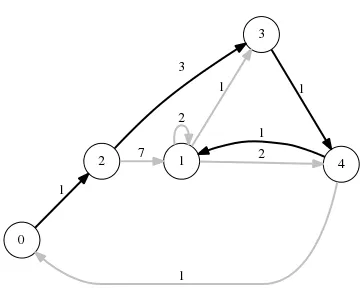我希望使用boost的dijkstra算法(因为我在程序的其他部分中使用了boost)。我的问题是如何将自定义对象(我认为它们被称为
基本上,我有一个自定义边缘类,它维护与边缘和通过它连接的顶点相关的所有信息。我想将我的自定义数据对象存储在需要
我已经成功地实现了boost提供的玩具示例。我尝试使用自定义属性,但没有成功(boost示例,boost属性)。如果只是将我的VEdge数据结构封装在一个结构体中,我可以接受,我只需要能够检索它。但是我无法弄清楚如何将我的自定义数据结构包含到boost
在我的情况下,我有以下程序:
我知道我的示例有些牵强,但它传达了我想要实现的目标。我知道我需要一个自定义数据结构来处理发送到图形typedef中的edge_descriptor。
所以,我想修改我的Dijkstra.h文件,使其看起来像这样:
property)添加到adjacency_list中。基本上,我有一个自定义边缘类,它维护与边缘和通过它连接的顶点相关的所有信息。我想将我的自定义数据对象存储在需要
adjaceny_list的边缘属性中。我已经成功地实现了boost提供的玩具示例。我尝试使用自定义属性,但没有成功(boost示例,boost属性)。如果只是将我的VEdge数据结构封装在一个结构体中,我可以接受,我只需要能够检索它。但是我无法弄清楚如何将我的自定义数据结构包含到boost
adjaceny_list结构中。在我的情况下,我有以下程序:
Main.cpp:
#include <iostream>
#include <fstream>
#include "dijkstra.h"
#include <vector>
int
main(int, char *[])
{
// Generate the vector of edges from elsewhere in the program
std::vector<VEdge*> edges; //someclass.get_edges();
td* test = new td(edges);
test->run_d();
test->print_path();
return EXIT_SUCCESS;
}
Dijkstra.cpp:
#include <iostream>
#include <fstream>
#include "dijkstra.h"
using namespace boost;
td::td() {
kNumArcs = sizeof(kEdgeArray) / sizeof(Edge);
kNumNodes = 5;
}
td::td(std::vector<VEdge*> edges) {
// add edges to the edge property here
for(VEdge* e : edges) {
// for each edge, add to the kEdgeArray variable in some way
// The boost example forces the input to be an array of edge_property type.
// So here is where I will convert my raw VEdge data structure to
// the custom edge_property that I am struggling to understand how to create.
}
kNumArcs = sizeof(kEdgeArray) / sizeof(Edge);
kNumNodes = 5;
}
void td::run_d() {
kGraph = graph_t(kEdgeArray, kEdgeArray + kNumArcs, kWeights, kNumNodes);
kWeightMap = get(edge_weight, kGraph);
kP = std::vector<vertex_descriptor >(num_vertices(kGraph));
kD = std::vector<int>(num_vertices(kGraph));
kS = vertex(A, kGraph);
dijkstra_shortest_paths(kGraph, kS,
predecessor_map(boost::make_iterator_property_map(kP.begin(), get(boost::vertex_index, kGraph))).
distance_map(boost::make_iterator_property_map(kD.begin(), get(boost::vertex_index, kGraph))));
}
void td::print_path() {
std::cout << "distances and parents:" << std::endl;
graph_traits < graph_t >::vertex_iterator vi, vend;
for (boost::tie(vi, vend) = vertices(kGraph); vi != vend; ++vi) {
std::cout << "distance(" << kName[*vi] << ") = " << kD[*vi] << ", ";
std::cout << "parent(" << kName[*vi] << ") = " << kName[kP[*vi]] << std::
endl;
}
}
void td::generate_dot_file() {
std::cout << std::endl;
std::ofstream dot_file("figs/dijkstra-eg.dot");
dot_file << "digraph D {\n"
<< " rankdir=LR\n"
<< " size=\"4,3\"\n"
<< " ratio=\"fill\"\n"
<< " edge[style=\"bold\"]\n" << " node[shape=\"circle\"]\n";
graph_traits < graph_t >::edge_iterator ei, ei_end;
for (boost::tie(ei, ei_end) = edges(kGraph); ei != ei_end; ++ei) {
graph_traits < graph_t >::edge_descriptor e = *ei;
graph_traits < graph_t >::vertex_descriptor
u = source(e, kGraph), v = target(e, kGraph);
dot_file << kName[u] << " -> " << kName[v]
<< "[label=\"" << get(kWeightMap, e) << "\"";
if (kP[v] == u)
dot_file << ", color=\"black\"";
else
dot_file << ", color=\"grey\"";
dot_file << "]";
}
dot_file << "}";
}
Dijkstra.h:
#ifndef _TEMPD_H_
#define _TEMPD_H_
#pragma once
#include <boost/config.hpp>
#include <boost/graph/graph_traits.hpp>
#include <boost/graph/adjacency_list.hpp>
#include <boost/graph/dijkstra_shortest_paths.hpp>
#include <boost/property_map/property_map.hpp>
using namespace boost;
typedef adjacency_list < listS, vecS, directedS,
no_property, property < edge_weight_t, int > > graph_t;
typedef graph_traits < graph_t >::vertex_descriptor vertex_descriptor;
typedef std::pair<int, int> Edge;
struct VEdge{
// custom variables here
VNode start;
VNode end;
int weight;
int id;
// other irrelevant data pertinent to my program that must be preserved
};
struct VNode {
// custom variables here
int x;
int y;
int id;
// other irrelevant data pertinent to my program that must be preserved
}
enum nodes { A, B, C, D, E };
class td {
public:
td();
td(std::vector<VEdge*>);
~td();
void run_d();
void print_path();
void generate_dot_file();
private:
Edge kEdgeArray[9] = { Edge(A, C), Edge(B, B), Edge(B, D), Edge(B, E),
Edge(C, B), Edge(C, D), Edge(D, E), Edge(E, A), Edge(E, B)
};
char kName[5] = {'A','B','C','D','E'};
int kWeights[9] = { 1, 2, 1, 2, 7, 3, 1, 1, 1 };
int kNumArcs;
int kNumNodes;
vertex_descriptor kS;
graph_t kGraph;
std::vector<int> kD;
std::vector<vertex_descriptor> kP;
property_map<graph_t, edge_weight_t>::type kWeightMap;
};
#endif
我知道我的示例有些牵强,但它传达了我想要实现的目标。我知道我需要一个自定义数据结构来处理发送到图形typedef中的edge_descriptor。
所以,我想修改我的Dijkstra.h文件,使其看起来像这样:
struct vertex_label_t {vertex_property_tag kind;};
struct edge_label_t {edge_property_tag kind;};
typedef property <vertex_custom_t, VNode*>,
property <vertex_label_t, string>,
property <vertex_root_t, ing> > > vertex_p;
typedef property <edge_custom_t, VEdge*>,
property <edge_label_t, string > > edge_p;
typedef adjacency_list < listS, vecS, directedS,
vertex_p, edge_p > graph_t;
typedef graph_traits < graph_t >::vertex_descriptor vertex_descriptor;

VEdge*元素之间没有任何相关信息,请详细阐述一下。也许可以删除无关的演示代码。 - sehe